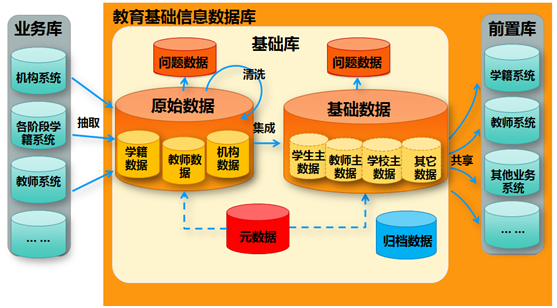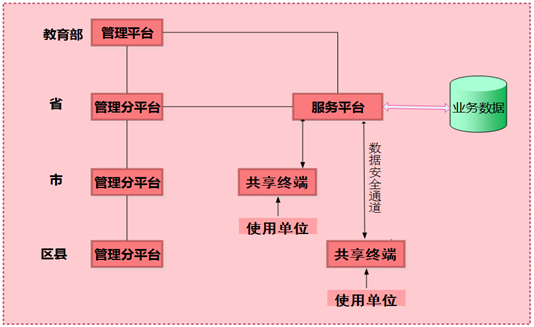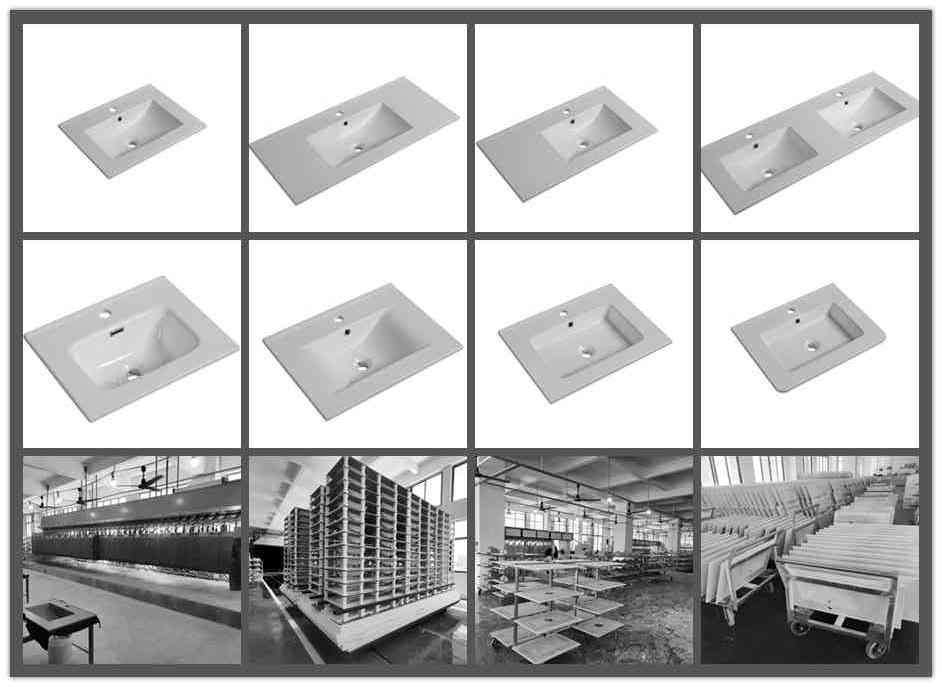Abstract: At present, the informationization of education management is being comprehensively promoted, the national education management information system is deployed and applied, and the basic database of education is basically formed. How to share the national education management information system data, and build a local general system and local characteristic system is the focus of the next stage of education management information construction. This paper analyzes the data sharing needs of the National Education Management Information System and the supporting platform for data sharing, and introduces the construction practice of data sharing in Fujian Province in detail.
Keywords: national education management information system data sharing research practice
introduction
After years of educational information construction, basic databases such as national institutions, students, teachers, and school buildings have basically taken shape. According to the requirements of “Core System Construction, General System Construction, and Characteristic System Construction†in the “Guidelines for the Construction and Application of Education Management Informationizationâ€, the focus of the next stage of education management information construction is the educational institutions (schools) The wide application of various types of education management information systems and the deep mining of data values. In the process of construction, it is necessary to realize the effective sharing of national education management information system data and efficient interconnection of services, and avoid new application islands and data islands.
1. National Education Management Information System data sharing needs
The National Education Management Information System has overall and comprehensive advantages, and educational institutions (schools) rely on various educational basic data for in-depth application.
1.1 Self-built business system data integration needs
Through the investigation of the construction of grassroots information systems, we found that education institutions (schools) at all levels basically have various types of business management information systems that were built but still in use. Due to historical reasons, there is no unified information standard and technical planning between self-built business systems. Some self-built business system functions are the same as the national education management information system, and the basic data is scattered, repeated, and isolated. Problems such as repeated data collection and data inconsistency result in inefficient work, and education management is increasingly dependent on data. Only through data sharing between systems can the problems encountered in the construction of grassroots management information systems be solved.
1.2 Data statistics analysis and decision support needs
At present, the education statistics mainly rely on manual querying relevant data from various business management information systems, and then enter the statistical system and report it. The source of the original data is many, and the time nodes are inconsistent, which objectively affects the quality of the statistical data. The various measures to deepen the comprehensive reform of education require comprehensive and accurate basic data and big data analysis support, which requires educational institutions (schools) at all levels to conduct comprehensive data analysis across systems based on management information systems and basic databases.
1.3 The need for innovative education management model
Modern technologies such as cloud computing, the Internet of Things, and big data are slowly changing the way people live, work, and think. In the era of big data, only educational institutions (schools) can integrate educational resources in central and provincial education data centers, share the latest educational basic data, and deeply explore the value of data in order to adapt to rapidly changing social needs and promote education management and education. The deep integration promotes the innovation of education and teaching management model.
2. Supporting platform for data sharing of national education management information system
Where the general system and the characteristic system need to use the basic data of the National Education Management Information System (such as students, teachers, etc.), the educational institutions (schools) can use the education basic information database management and service platform (hereinafter referred to as the "base library platform") and the country. The core business system integration and open sharing platform (hereinafter referred to as "open sharing platform") obtain relevant data.
2.1 Education basic information database management and service platform
The basic library platform is deployed in the Ministry of Education and the provincial data center. The basic database management is developed by the Ministry of Education to develop a unified indicator system, data source information and extraction models, and is distributed to the provincial level through interaction. Metadata issued by the provincial level will be issued at the provincial level. Load and expand and adjust as needed. The base library links business systems as a unified data export to address data needs between different business systems. Through the basic library platform, data sharing between the national education management information system and the national education management information system and the provincial self-built business system in the provincial data center can be realized.

Figure 1 Education basic information database management and service platform data sharing model
The basic library platform first extracts a piece of original data from the national business systems and saves it to the basic database. The metadata is uniformly described and managed in the basic database to form a complete original data; then the raw data of each stage is cleaned. According to certain rules, the main data of students' basic information, status, basic information of faculty, status, and basic information of the school are integrated to form main data with students, teachers and schools as the main line; raw data, integrated master data, and archive The data will be used as the data resource of the base library. The basic library platform pushes data to the pre-stores of each business system according to the requirements of data sharing of the business system according to certain synchronization rules, and each business system acquires the required functions of the system from the pre-store according to the data sharing manner provided by the basic library. Share data.
2.2 National core business system integration and open sharing platform
The open sharing platform consists of a management platform, a service platform, a software system for sharing terminals, and a basic support facility. The management platform is deployed in the Ministry of Education. The service platform and data sharing services are managed through data access control, data security system construction, and data synchronization service policies. The management organizations at all levels can log in to the platform. The service platform is deployed in the provincial data center, and obtains data from the provincial base library platform and provides data services for educational institutions (schools) at all levels. It is a specific implementation part of the data fusion and sharing service. Shared terminals are deployed at educational institutions (schools) below the provincial level and are responsible for providing secure data sharing channels for extended applications. The basic operating environment such as network and security is prepared by educational institutions (schools) at all levels in accordance with relevant technical requirements.

Figure 2 National core business system integration and open sharing platform architecture
The open sharing platform is the only channel for educational institutions (schools) below the provincial level to extend the application of national education management information system data. Educational institutions (schools) can access data of national education management information systems within the scope of access through shared terminals and data security channels. At the same time, educational institutions (schools) can also interface with common systems at all levels according to the open sharing platform interface specification, sharing common system basic data. Provide integrated management information services through an open sharing platform to achieve the integration and data sharing of the Ministry of Education, provinces, cities, counties (districts), and school information systems, so that educational institutions at all levels (schools) can apply systems based on national education management information systems. .
3. Practice of data sharing in national education management information system
In October 2015, the Ministry of Education launched a pilot base platform platform in Fujian Province. The pilot work included basic library platform deployment and platform application training. After the pilot work, we immediately started the construction of data sharing for the Fujian Provincial Free Textbook Accounting System.
3.1 Basic situation
"Fujian Province Free Textbook Subscription Accounting System" is a local general-purpose system that was launched in 2013. Its main function is to manage the free textbook subscription, distribution, accounting, and recycling. The number of students who enjoy free textbooks in each school in the system is exported by the system administrator from the national primary and secondary school student registration system every half month, and then manually imported into the free textbook system for batch update. The school cannot change. The student's student status changes dynamically every day. Because the student information is not shared in real time, the number of students in the free textbook system cannot reflect the actual situation. The school's free textbook accounting work is often plagued by this problem, which greatly reduces the work efficiency.
3.2 Construction process
3.21 demand analysis
The free textbook system needs to share a data table containing the school code, school name, grade name, number of students in the school, and in order to ensure data synchronization, the time stamp identification field and the read identifier field are added to the shared data table. The data to be shared is extracted from the school information table, the student information table, and the grade information table in the elementary and middle school base database of the basic library platform, and the basic library platform pushes the extracted shared data to the pre-database sharing after the basic database data is updated every day. data sheet. The free textbook system regularly reads the shared data table of the pre-stored database every day to achieve data sharing.
3.22 Creation and registration of shared data tables
Considering the security and scalability of shared data, an instance is created separately on the database server as a pre-database for the provincial self-built business system. Create shared data tables and users in the instance, and give the user permission to read and write. Log in to the base library platform, register the pre-stored library (provincial self-built business system), test the connection and obtain the shared data table information.
3.23 data integration model design
Create a data sharing task (the number of students in the free textbook system) on the base library platform. The data source of the task is the base library and the pre-database. Create a new business for the data sharing task (the number of graded students in the school), the business type is the extraction class, and the service is referenced in the data sharing task.
Use the data integration designer to create a new job (the number of students in the grades), the table input of the job is the basic library of the primary and secondary school students, and the table output is the provincial free textbook system data sharing table of the pre-stored library. The SQL statement for data extraction is:

The job is edited and saved and published to the server. In the basic library platform, the assignments (statistics of the number of students in the grades) are registered in the business (the number of students in the grades).
3.24 data integration model scheduling
In the running schedule management module of the base library platform, select the service (the number of students in the graded school) and run it. Run the configuration: the service type is period, the type is day, and the time is 5 points. Since the base library data is incrementally updated every day at 1 am, the basic library platform is pushed forward to push the data to be shared by the free textbook system at 5 am every day, and the time stamp and the unread flag are written in the data sharing table. .
3.25 shared data call
The free textbook system periodically accesses the shared data table of the pre-store every day according to the provided username and password, and judges whether the data is updated according to the timestamp identifier. If there is an update, the updated data is synchronized to the system, and the read flag is written in the read identification field of the shared data table; if there is no update, no operation is performed.
3.3 Construction effect
Through data sharing, the frequency of updating the number of grade-level students in the free textbook system is adjusted from once every half month to once a day, basically achieving data synchronization with the national primary and secondary school students' information management system, which solves the problem that the number of students is inaccurate. The problem of accounting text error in free textbooks greatly improves the efficiency of accounting. At the same time, the data sharing application has prompted the school to pay attention to the student's student status management work, and timely record the student change information in the national primary and secondary school student status management information system to ensure the authenticity and accurate evidence of the system data.
Conclusion: Although the basic conditions for data sharing in the National Education Management Information System are already in place, educational institutions (schools) can use information sharing for deep application and data mining, but to provide big data for various measures to deepen the comprehensive reform of education. The supporting goals should also be accompanied by appropriate policies and incentives to promote this work.
(Fujian Education Management Information Center Chen Yufei)
Undercuonter Bathroom Sink. offers a simple, compact and highly adaptable solution for any bathroom space. Create a seamless counter-to-basin transition. Sleek styles and ease of cleaning are what makes these the preferred design choice. Our bathroom sinks come in styles and installations to match any lifestyle
Bellamar are specialized in Ceramic basins for over 20 years, located in Chaoshan, China with 2,2000㎡ workshop, +100 employee.. Our monthly export volume is 40 containers, mainly to Europe, Asia.
Our Advantage is:
1. complete Size & Color
2. High quality
3. Competitive price

Under Countertop Basin,Undercounter Washbasin,Small Ceramic Wash Basin,Under Counter Top Wash Basin
BELLAMAR SANITARY WARE CO., LIMITED , https://www.bellamarbath.com
